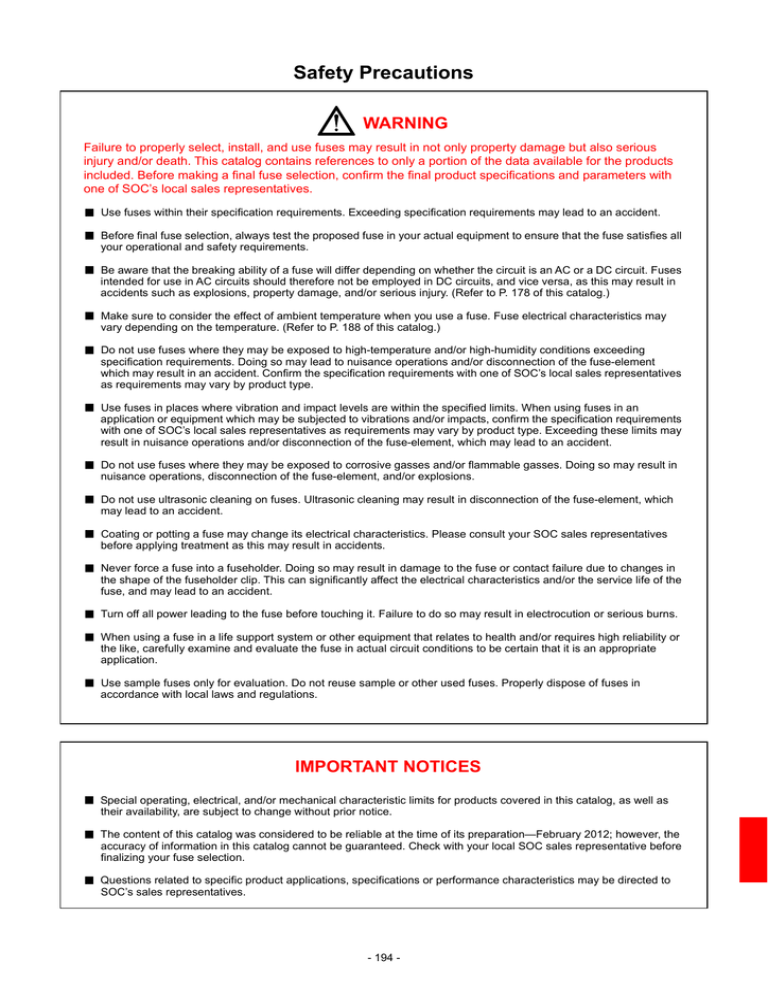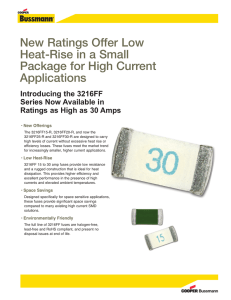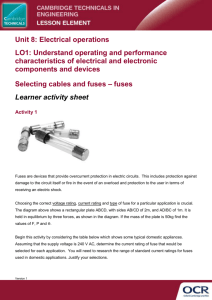Safety Precautions/Warning
advertisement

Safety Precautions WARNING Failure to properly select, install, and use fuses may result in not only property damage but also serious injury and/or death. This catalog contains references to only a portion of the data available for the products included. Before making a final fuse selection, confirm the final product specifications and parameters with one of SOC’s local sales representatives. ■ Use fuses within their specification requirements. Exceeding specification requirements may lead to an accident. ■ Before final fuse selection, always test the proposed fuse in your actual equipment to ensure that the fuse satisfies all your operational and safety requirements. ■ Be aware that the breaking ability of a fuse will differ depending on whether the circuit is an AC or a DC circuit. Fuses intended for use in AC circuits should therefore not be employed in DC circuits, and vice versa, as this may result in accidents such as explosions, property damage, and/or serious injury. (Refer to P. 178 of this catalog.) ■ Make sure to consider the effect of ambient temperature when you use a fuse. Fuse electrical characteristics may vary depending on the temperature. (Refer to P. 188 of this catalog.) ■ Do not use fuses where they may be exposed to high-temperature and/or high-humidity conditions exceeding specification requirements. Doing so may lead to nuisance operations and/or disconnection of the fuse-element which may result in an accident. Confirm the specification requirements with one of SOC’s local sales representatives as requirements may vary by product type. ■ Use fuses in places where vibration and impact levels are within the specified limits. When using fuses in an application or equipment which may be subjected to vibrations and/or impacts, confirm the specification requirements with one of SOC’s local sales representatives as requirements may vary by product type. Exceeding these limits may result in nuisance operations and/or disconnection of the fuse-element, which may lead to an accident. ■ Do not use fuses where they may be exposed to corrosive gasses and/or flammable gasses. Doing so may result in nuisance operations, disconnection of the fuse-element, and/or explosions. ■ Do not use ultrasonic cleaning on fuses. Ultrasonic cleaning may result in disconnection of the fuse-element, which may lead to an accident. ■ Coating or potting a fuse may change its electrical characteristics. Please consult your SOC sales representatives before applying treatment as this may result in accidents. ■ Never force a fuse into a fuseholder. Doing so may result in damage to the fuse or contact failure due to changes in the shape of the fuseholder clip. This can significantly affect the electrical characteristics and/or the service life of the fuse, and may lead to an accident. ■ Turn off all power leading to the fuse before touching it. Failure to do so may result in electrocution or serious burns. ■ When using a fuse in a life support system or other equipment that relates to health and/or requires high reliability or the like, carefully examine and evaluate the fuse in actual circuit conditions to be certain that it is an appropriate application. ■ Use sample fuses only for evaluation. Do not reuse sample or other used fuses. Properly dispose of fuses in accordance with local laws and regulations. IMPORTANT NOTICES ■ Special operating, electrical, and/or mechanical characteristic limits for products covered in this catalog, as well as their availability, are subject to change without prior notice. ■ The content of this catalog was considered to be reliable at the time of its preparation—February 2012; however, the accuracy of information in this catalog cannot be guaranteed. Check with your local SOC sales representative before finalizing your fuse selection. ■ Questions related to specific product applications, specifications or performance characteristics may be directed to SOC’s sales representatives. - 194 -

